-
General information
-
Account Settings
- Creating & managing your personal doo account
- Organization settings: Managing your account settings
- Multi-user: Working as a team
- How to reset your password
- Changing the email address of your doo account
- The doo account packages
- What can I do if a doo site does not load
- Adjusting standard labels and texts of the doo booking process
- How do I delete my account
- Payment Process: How to manage payment options
- Password Security using doo: What options are available?
-
Events
-
- Edit email contents
- Using placeholders in booking email templates
- How to adjust invoice contents
- Attendee tickets and QR code scanning
- What do doo tickets look like?
- E-mail attachments for bookers and attendee
- Certificates & Co: Create custom documents
- Define your own booking conditions
- Revenue Disbursement: Entering and editing invoice address & bank account information
- Create bilingual (multilingual) events
- Bookings with manual approval
- Create a waiting list
- Access codes and promotion codes: Discounted tickets for your participants
- doo Widgets: Integration into your own website
- doo Default Event Website and Custom Event Website
- How to create a booking process in english
- Providing flyers, event programs or direction sketches
- How does the booking process work for my attendees?
- How do I make test bookings?
- Creating exclusive registration access for selected contacts
- Delete ticket categories & change prices and sales periods after go-live
- Cancellation of events
- What are event fields and how do I use them best ?
- Shorten the booking process and prefill data: How to make the booking process as convenient as possible for bookers
- Tips for virtual events with doo
- Integration into your own Facebook page
- Event Templates: Creating templates for your events
-
Manage Bookings
- Manage bookings and attendees
- Monitoring incoming bookings
- The attendee overview
- Invitation list: Track the registration status of specific contacts
- Manual registration
- Resend automatically generated emails
- Rebooking: How to change existing bookings
- Cancellation & Refund Handling
- Booking self-service: Allow bookers to subsequently access and edit their bookings
- Download booking overview and attendee list
- Change of attendee data and invoice address
- Bank transfer: How to deal with pending transactions
- What to do, if someone has not received their confirmation e-mail or ticket
-
Contact Management
- Contacts: Introduction and Topic Overview
- Contact details: Collect cross-event contact information
- Overview contact data fields
- Managing contact data fields
- Creating contacts - How do contacts get into the doo contact center?
- Contact import - Bulk creation and editing of contacts
- Managing existing contacts
- Creating and managing contact groups
- Datamatching & Synchronization of booking data and doo contact
- Email subscriptions: Double opt-in & opt-out options at doo
- Deleting contacts
-
Emails
-
Websites
- The doo website editor: create an individual event page
- Mobile optimization: Customize your site for all your devices
- Installing different tracking tools on the website
- Creating a SSL certificat (HTTPS) to ensure data security
- Website Tracking: How to integrate doo into your Google Analytics To be Created
-
Additional Functions
- Optional Service: Refund handling via doo
- Ticket design: How to get your ticket in the desired design
- Forms - Set up surveys and feedback requests for your attendees
- Embedded Reports
- Customer specific sender emails
- Email inbox: How to manage email requests from your participants within doo
- Add calendar entries to your event communication
- Filtered cross-event widgets: How to show only selected events
- Widgets and Accessibility
-
Automations
-
Booker & Attendee FAQ
-
On-Site and Attendance
Payment Process: How to manage payment options
For fee-based events, doo offers a range of different payment options that can be set up for your account upon request. You can find out which options are available here.
In this article you will learn how to individualize the payment options enabled for your account and how to define for each event which payment methods should be displayed to your bookers in which booking screen.
The following topics are covered in the article:
1.Manage your account payment options
To view and manage the payment options set up for your doo account, click the gear icon at the top right of your doo Event Manager to go to the organization settings.
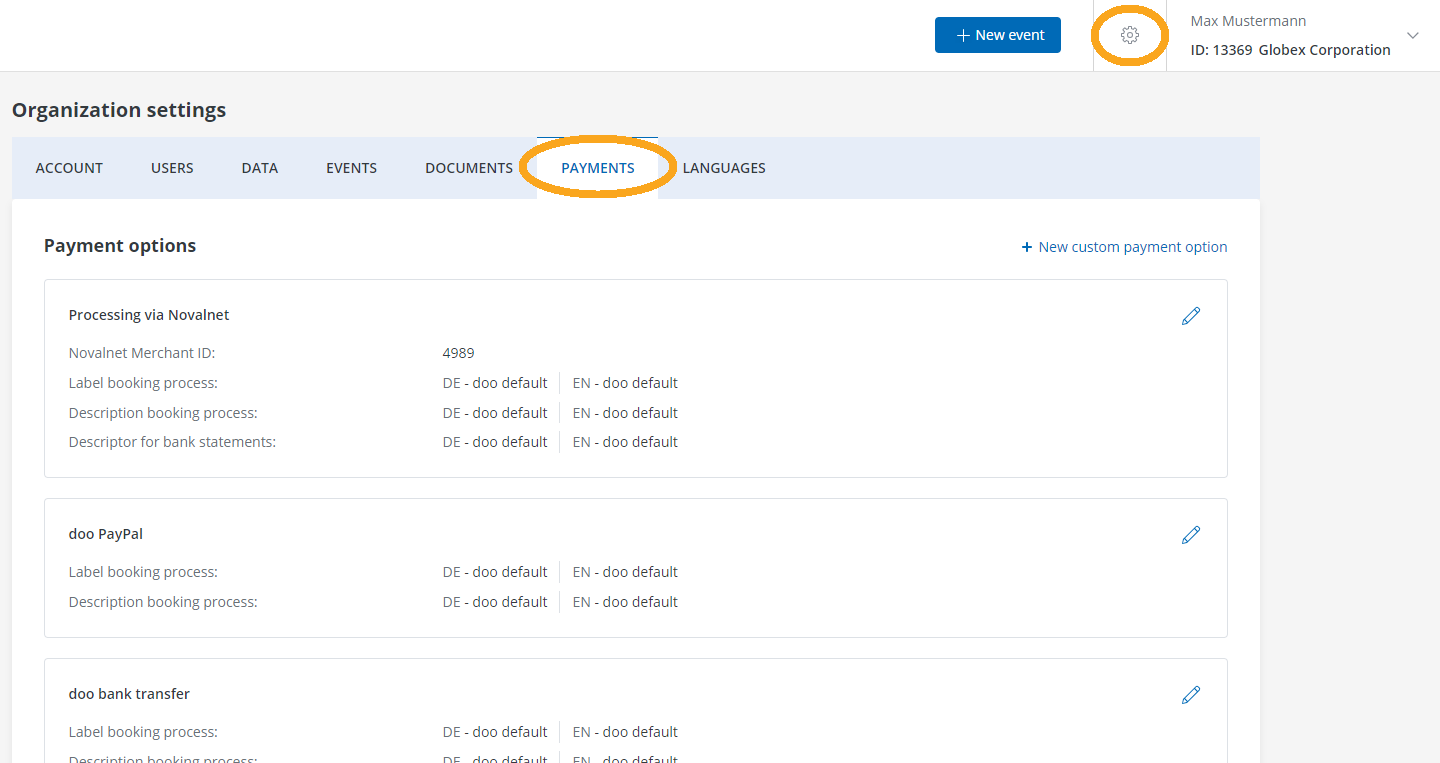
Then switch to the “Payments” tab to access your account’s existing payment options.
1.1 Rename existing payment options
Here you can view and customize your organization’s existing payment options by clicking on the pencil icon.
Payment options are set up with the doo default names and descriptions for your account, but can be renamed individually afterwards to give your bookers more detailed information about the corresponding payment methods on the payment page. If no custom name and description is provided, a doo default text will be used. For example, the default text for the payment method “doo bank transfer” will be displayed to the booker as follows:

To replace the standard text of a payment option, simply write the desired name or description in the corresponding fields. If you offer booking masks in German and English for your events, remember to make the appropriate entries for both languages and then save them.
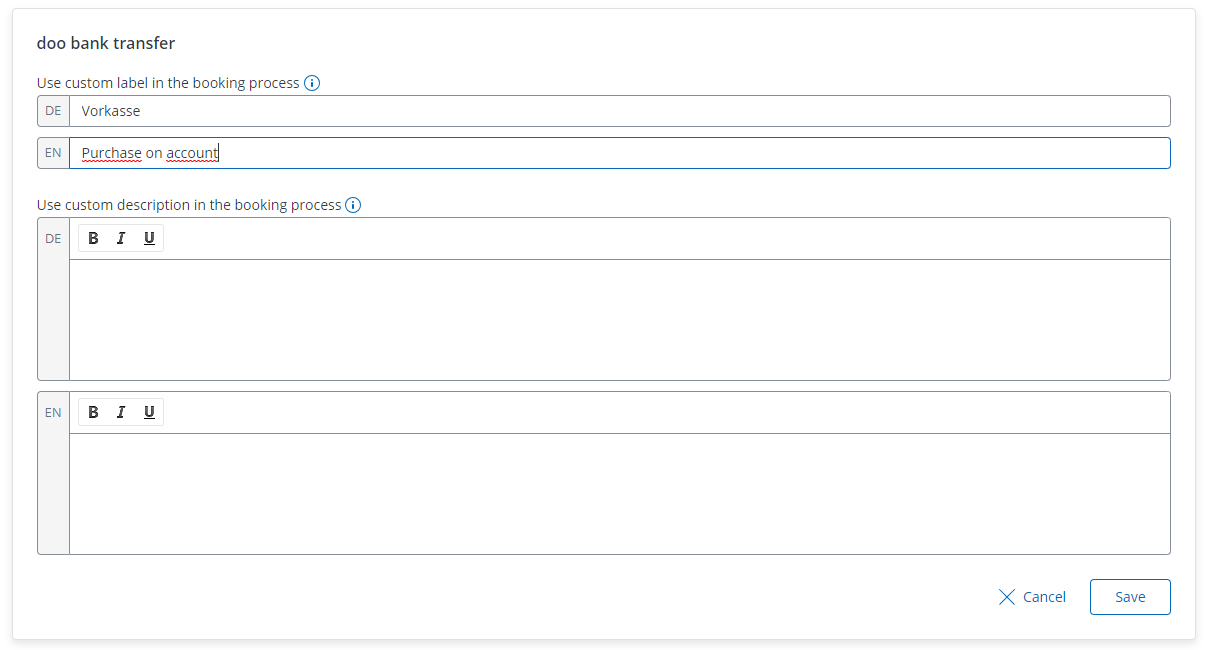
1.2 Add a new payment option
After consultation with your doo counterpart, additional payment options can be activated for your doo account (more details about the options can be found here). After the activation by our team you can define the name and details of the new option yourself by clicking on the button “New custom payment option”.
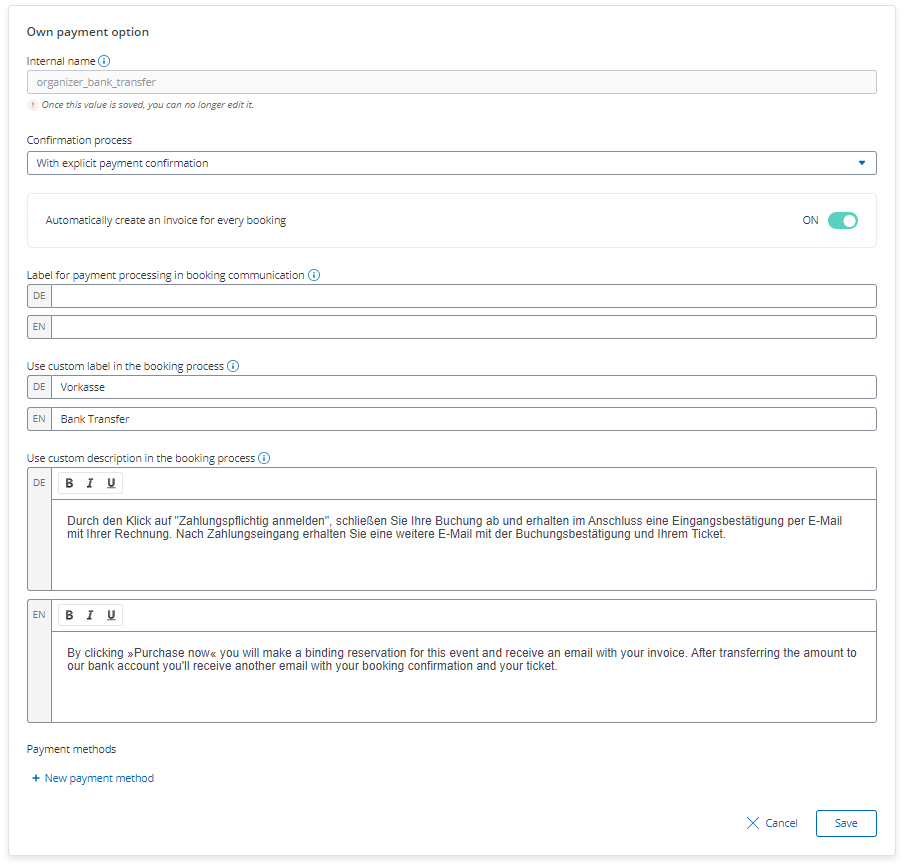
1.2.1 Internal name
Under the “Internal Name” item, you can specify how your new payment method should be named internally. The internal name for the payment option must be unique and must not contain any umlauts, special characters or spaces so that it can also be used for technical integrations. Please also note that once the name has been saved, it cannot be changed for technical reasons.
1.2.2 Confirmation process
In the “Confirmation process” field, you can select whether the new payment option should take place with or without explicit payment confirmation. Depending on which settings are stored for your organization, either both or only one of the two options are available.
Without explicit payment confirmation
If you select “Without explicit payment confirmation”, new incoming chargeable bookings with this payment method will be confirmed directly and marked as active or paid. If you have activated tickets for your event, they will be sent directly. This option is suitable, for example, for events for a group of people known to you, to whom you would like to send an invoice following the booking outside of doo. With the immediate ticket dispatch, you can thus virtually make advance payments, because you trust that the bookers will pay their invoices afterwards.
With explicit payment confirmation
If the option “With explicit payment confirmation” is selected, the receipt of payment must first be confirmed for each booking before the tickets are sent. This option can be used, for example, if you want to offer “purchase on account” to your own account. After a booker has transferred the invoice amount to your account, you can confirm the payment manually in doo and only then the booking will be marked as active and paid and the ticket will be sent.
Here is an example of how the booking details look like for a booking with explicit payment confirmation, where the receipt of payment is not yet confirmed.

The option with explicit payment confirmation is also used for the technical integration of external payment service providers, which are integrated into the booking process and automatically transmit to doo when a payment was successful.
1.2.3 Automatically create an invoice for every booking
You can set whether an invoice should be generated and sent automatically by doo for each booking. By default, this option is preselected, but you can also deactivate it if you prefer your own invoicing outside of doo.
1.2.4 Label for payment processing in booking communication
Here you can enter the name of the payment service provider as it should be displayed to the booker after booking, e.g. in the booking portal. If you have e.g. integrated your own payment service provider in doo, it is recommended to enter the name of the service provider here for an easier assignment, as this will appear as the payee in the account statement of your bookers. If you leave the field empty, this additional information will not be displayed, but only the name as it was used in the booking process (see next point).
1.2.5 Use custom label in the booking process
Here you can define what should be displayed to the booker when selecting the payment option in the booking process. This information is also displayed in the booking portal after the booking has been made. If you do not specify a designation, a doo default designation will be used.
1.2.6 Use custom description in the booking process
The description is displayed in the booking process after the payment option is selected. Use this field to explain to the bookers how the payment process will look like in the next step, so they know how the further process will look like. If you don’t specify a description here, a doo default text will be used.
In some cases, it is useful to additionally store payment types for the payment option you have just created (see next point). Otherwise, you can now save the new payment option and use it from now on for your events.
1.2.7 Add payment methods
The option to create different payment types for a payment option is aimed at those organizers who have an external payment provider integrated into doo as their own payment option with explicit payment confirmation and this provider offers several payment types such as purchase on account, credit card, direct debit and PayPal. After selecting the appropriate payment option, the booker will be redirected to the payment provider’s page. By your entries here you can define how the available payment methods should be named on the page.
For each available payment type, a new entry in doo must be created accordingly and an internal name assigned. For technical reasons, the same rules apply to the internal name of a new payment type as to the internal name of a payment option (see 1.2.1.).
For each payment method offered, please specify the name for the German and English booking process.
In principle, a payment type can also be created for payment options without explicit payment confirmation in order to include an intermediate step in the booking process by having bookers reconfirm the selected payment option in a new window. In this case, however, it is not possible to create multiple payment types for the same option – for this use case, multiple payment options should be created instead.
If at least one payment method has been stored, you can also optionally set it to be preselected in the booking process to simplify the process for your bookers.
Then click “Save” to create your new payment method.
The new payment option is now displayed in the overview together with the previous payment options.
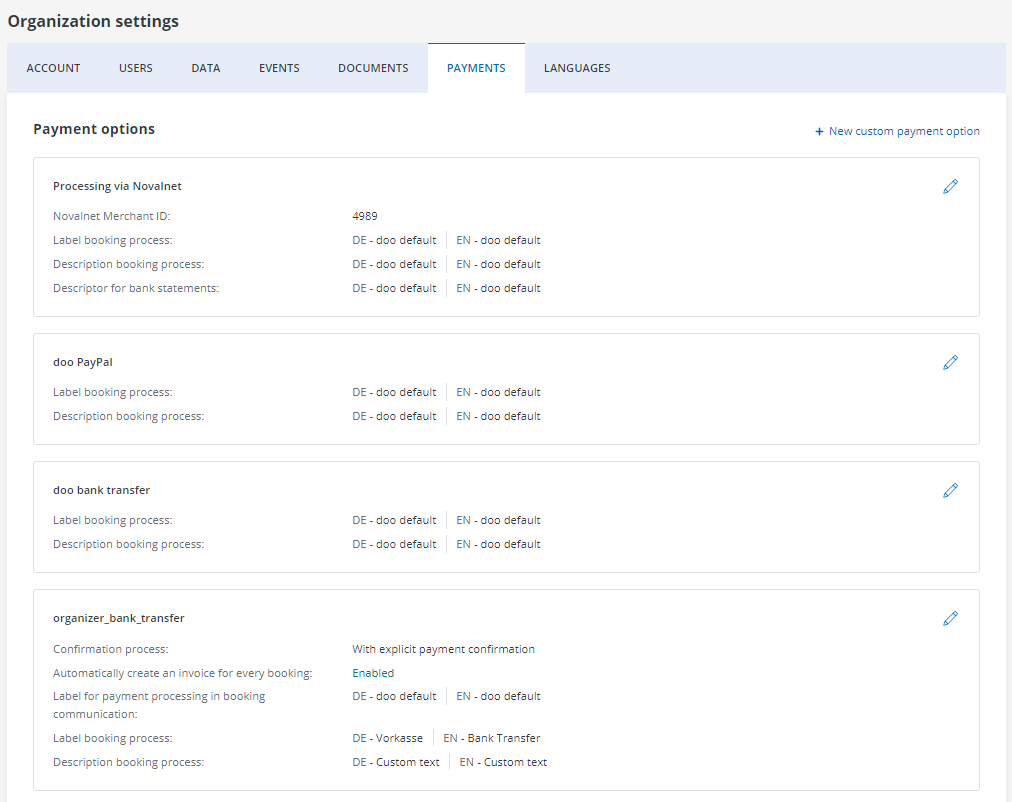
2. Manage payment options of an event
For each paid event, you can individually set which payment options should be offered. You can access these settings by opening the event and clicking on “Payments” in the settings menu on the right.
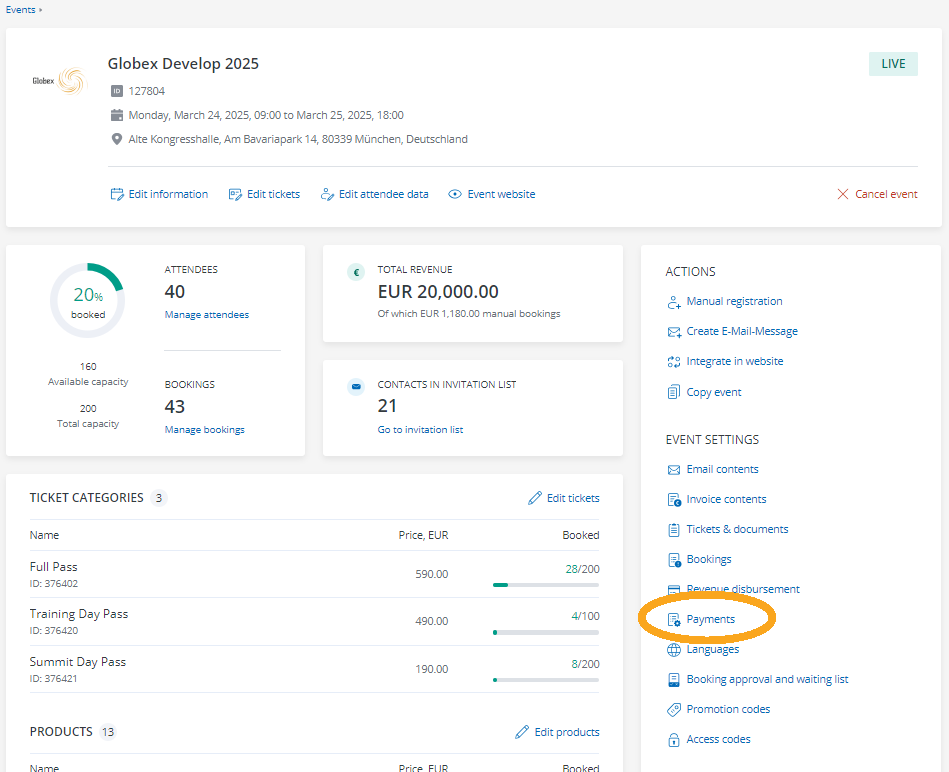
2.1 Set payment options for an event
All payment options stored for your account (see 1.) are available. To activate or deactivate individual options, click on the pencil icon.
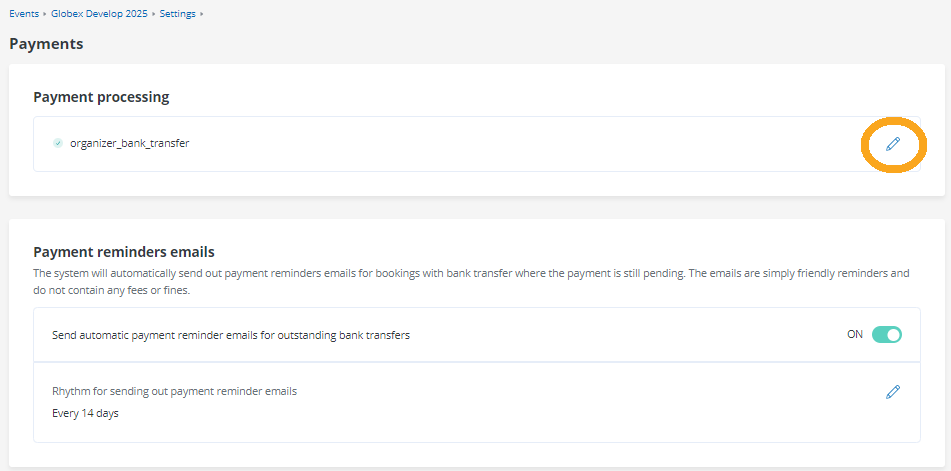
By clicking the respective checkbox, you can add or remove the corresponding payment options for the event.
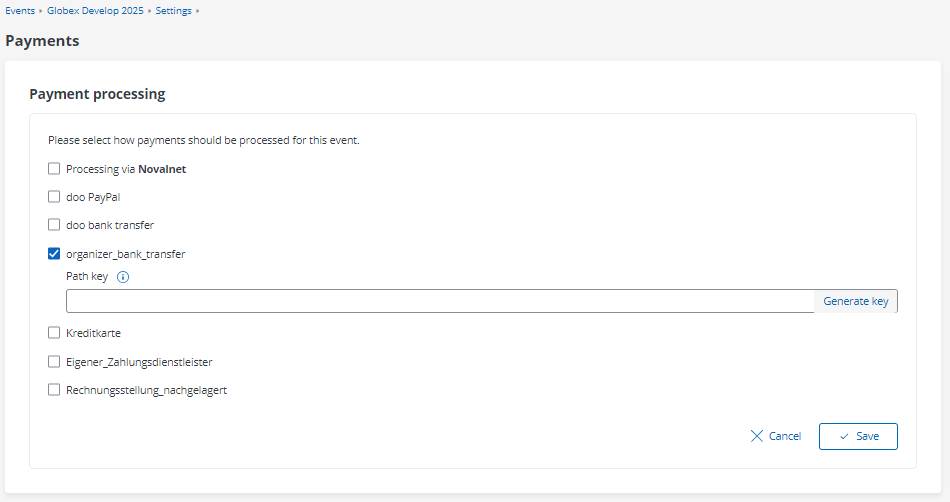
2.2 Pfadschlüssel: Zahlungsoptionen einzeln ausblenden
If you use doo widgets (see integration into your own homepage) to integrate different doo booking masks into your website, you can define that a certain payment option should only be displayed in one or also several specific doo widgets. This works by using a path key: once you have created a custom path key for a payment option, it will only be displayed to the booker when booking via a doo widget in whose widget code you have manually integrated the corresponding path key. In all other widgets as well as on the doo event website, the option is not displayed.
This option can be very useful if you want to address different target groups with your events via different booking paths or event pages in each case, such as new customers and existing customers or employees and external guests.
This is then how the setup takes place:
1. Create one doo widget per target group (read more here), which you want to be integrated on different pages.
2. To offer a payment option to one group, which should not be available to the other group, create a path key for this option in the payment settings of the event respectively. The path key must be 24-32 characters long and consist of numbers, upper and lower case letters. We recommend using a random string to prevent tech-savvy bookers from discovering hidden payment methods. You can also get a random string by clicking the “Generate key” button. This method will then not be displayed on any booking screen for the time being.
3. To enable the payment option again for a specific widget, integrate the created path key into the corresponding widget code by inserting the bold marked line with the corresponding path key into the code.
<div data-viovendi-locale="<locale>" data-viovendi-event="<eventID>" data-viovendi-organizer="<organizationID>" data-viovendi-widget-config-name="<configName>" data-viovendi-path-keys="<Pfadschlüssel1>,<Pfadschlüssel2>"> </div> <script type="text/javascript" src="https://doo.net/viovendi-embed.js" data-viovendi-version="1"></script>
4. To pass multiple path keys, add them each with a comma:
data-viovendi-path-keys=”<Pfadschlüssel1>,<Pfadschlüssel2>”>
IMPORTANT: The use of path keys is suitable for events where the payment process should take place directly as part of the booking via the widget. If you work with manual approval for your event, where the payment is delayed, only the unencrypted payment options will be offered to the booker after approval, the options with path keys cannot be displayed for technical reasons.
2.3 Payment reminder emails
If you offer your bookers purchase on account or prepayment as payment options, you can set automatic payment reminders to be sent at a certain frequency for payments that have not yet been settled. After the switch is activated, you can enter the number of days in which the payment reminders should be sent.
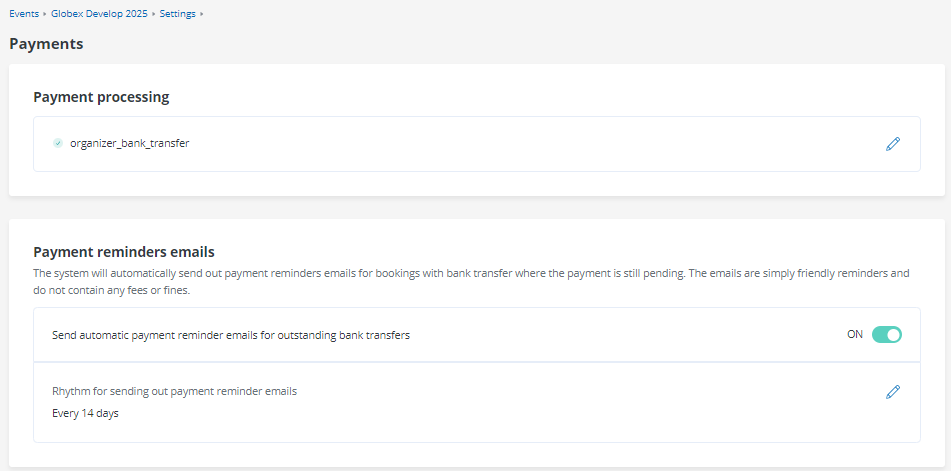
Note: These are only payment reminders via email with attached invoice each, not reminders! Reminders would have to be created and tracked outside of doo.
If you do not need the reminder function, you can simply disable the switch.
